
Imperial Home Page -> Imperials by Year -> 1937 -> Spotter's Guide
Chrysler had not been satisfied with the Briggs engineered new bodies of its 1935-36 models, so for 1937 it engineered new bodies for all its makes, though Briggs still built most of them. By this time, Chrysler also had some body stamping, some welding, and finishing facilities of its own. Boasting one piece roof construction, the '37 body shells would be retained with a minor facelift for 1938 and with a major one for 1939.
Ray Dietrich was still in charge of styling, and Chrysler Corporation's 1937 cars bore his imprint. This year he adopted a rounded curved theme and used minor trim differences- grilles, hood vents, moldings, and other body hardware- to set the various makes apart from one another. He also supervised the final facelift for the ill-starred Airflow, which was now restricted to a single 2 model series in the Chrysler line. Designated series C-17, it was built on the 128 inch wheelbase chassis of the previous Airflow Imperial 8, and supported a gently raked and rounded front, both of which made this arguable the best looking Airflow of all and oddly enough, the basic design no longer looked so odd in its 4th year on the market. Time had finally caught up with the Airflow and the styling elements that had seemed so radical in 1934 were now more or less established design orthodoxy in Detroit. Perhaps it hadn't been "wrong" after all.
Corporate engine availability was simplified this year by restricting straight 8 to Imperials and the lone Airflow series and discontinuing the 385 cubic inch 8. Everything else on the model roster was powered by an L-head 6. The workhorse 241.6 CID 6 was replaced by a short stroke 228 CID version of same for the DeSoto and the low end Chrysler.
Plymouth arrived on a 1 inch shorter wheelbase (112 inches) for 1937, but the cars looked longer thanks to hood/ body proportions thanks to Dietrich. The engine, still the old faithful 201.3 CID 6, was pushed 6 inches forward in the chassis, and a stabilizer bar appeared between the front wheels. The same array of body styles returned in 2 series, the P-3 Business and P-4 DeLuxe. The later still included a seven passenger sedan and limousine, but their wheel base was an even longer 132 inches, up 7 from their 1936 counterparts. There were no noteworthy mechanical changes for 1937 Plymouth. Prices averaged about $15.00 higher than 1936, perhaps reflecting the countries return to "good times"- at least compared to recent years. Along with other Chrysler Corporation makes, Plymouth stressed a "safety styled" interior this year, featuring recessed control knobs and a rounded off lower edge for the dash, plus a roll of "crash" padding on the front seatbacks and interior door handles curved inward so as to avoid snagging occupants' clothes. A blower fan and hidden defroster vents became standard (the later devised by Fred Selje). Plymouth marked another milestone this year with the production of its 2 millionth car this year.
Dodge carried on with a single 6-cylinder series, coded D-5. As at Plymouth, the 7 seat sedan and limousine returned on their longer chassis, in this case, 132-inches ( up 4 ), while standard models lost an inch. Everything else stayed the same except prices, which were somewhat higher. The line leader business coupe went from $640 to $715, while the attractive but slow selling convertible sedan rose from $995 to a hefty $1230. As elsewhere in the industry "trunkback" styles had far outstripped "trunkless" sedans in popularity by this time.
Many of the above comments also apply to this years DeSoto line, now bereft of the unlamented Airflow. DeLuxe and Custom models disappeared, as did the use of the Airstream name, replaced by a single series of designated S-3. The standard wheelbase shrank by 2 inches to 116 and the brace of long chassis sedans was stretched 3 inches between wheel centers to 133, thus aligning DeSoto precisely with the 6-cylinder '37 Chryslers. Overall appearance can be fairly described as lumpy but DeSoto avoided Chryslers ungainly "high-nosed" look thanks to hood side trim artfully blended into the barrel-shaped radiator. Though it moved up only one notch in industry standings, DeSoto recorded more than double its 1936 production volume for the model year.
Chrysler likewise abandoned the Airstream name for 1937 and carried out a similar model consolidation at the bottom of its lineup. The junior offering were now sold under the Royal nameplate, officially series C-16 and were powered by the new short stroked 6 previously mentioned. Body and chassis were shared with DeSoto but frontal styling was far less pleasing. Apart from the Airflow, 8 cylinder power was reserved for the Imperial, which reverted to conventional styling since 1934. It was offered as the 121-inch wheelbase C-14 with a choice of 6 body styles and as the 140 inch wheelbase C-15 Custom, the later aimed mainly at the "carriage trade." The familiar 274 CID straight 8 was standard for the C-14, while the Custom shared the Airflow's 323.5 CID 8, now the largest engine in the corporate camp.
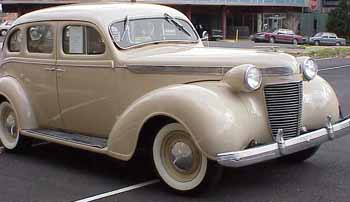
|
THE C-14 SEDAN (4-doors) |
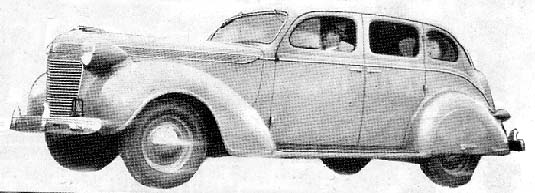 |
THE TRUNK
|
|
Here is an example of the trunk on the '37 sedan. This feature was called "trunkback" as opposed to the "trunkless" style which was no longer popular. |
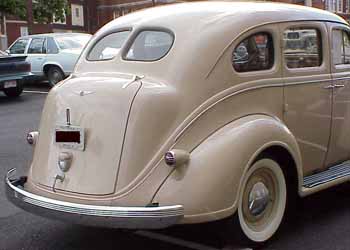 |
And another photo showing the trunk. Notice the exterior hinges which was still predominant in the auto industry on luxury cars. |
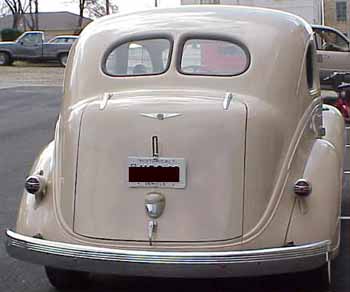 |
Here is what the trunk looks like from the rear. The two small windows above the trunk are a nice touch on this beautiful sedan. |
 |
This inside shot of the trunk shows how much room was available in these compartments. The spare tire takes up NO room!! |
EXTERIOR CHROME AND EMBLEMS
 |
The '37 bumper was still an attached piece that sat away from the car. The integrated bumper had no been introduced yet. The trunk handle is also visible in this shot. |


 |
Here are 3 detailed shots of the taillights. They each had a chrome bezel and a chrome detail on the face of the lens. Notice that the shape of the taillight is very similar to the general shape of the headlight (next picture). |
|
|
Here is a side view of one of the headlights. The headlight pods were enormous on the '37 and stood alone, attached to the body (detailed in the picture below). |
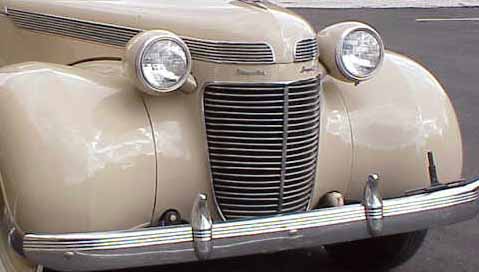 |
Here is a picture of the complete front clip. The headlight, front grille, front bumper, Imperial emblems and hood chrome is all visible. |
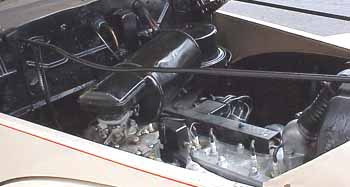 |
All Imperial for '37 came standard with the 274 straight 8 engine, often referred to as the flat head. |
|
|
|
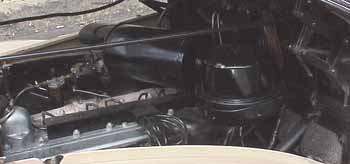 |
Another shot of the flat head. This engine is extremely dependable and a core piece of Chrysler Corporation from 1931 to1950, when the 331 hemi came into use. |
|
|
|
|
Here are two views of the dash on a C-14. Though it is simple and straight-forward, it is very elegant for its day. |
|
|
A detailed shot of the left hand dials. Notice the "Chrysler Imperial" script at the center of the 4 gauges. |
|
|
A picture showing the dash from the passenger's point of view. |
|
|
This sedan has suicide doors and this picture reveals the door panels. These doors have a very interesting shape and the windows at the top are also shaped to fit the overall feel of the car. |
|
|
The windshield on the '37 was a flat glass piece with the wipers on the top. |
|
|
Here is a detail shot of the passenger-side windows. The three windows flowed with the overall shape of the car. |
|
|
Here are the rear windows. They almost appear to fit together, like a puzzle. |
|
|
Here is a picture from the interior of a sedan, looking out the rear windows. The small rear window is classic style from this period. |
|
|
|
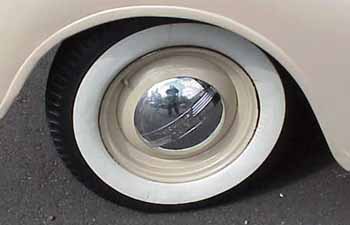 |
The wheel well for the '37 sported wide white wall tires with the dish type hubcap. |